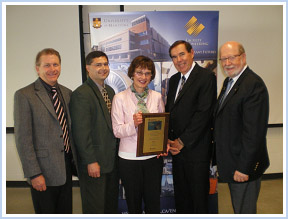MINERVA 2010 E-NEWSLETTER
| In this issue: |
Vol. 10/No. 1 Fall 2010
|
This January, Minerva increased its participation in the Inter-Collegiate Business Competition (I.C.B.C.) at Queen’s University as a Platinum sponsor and contributor of its first-ever Human Resources Health and Safety business student competition. Thanks to Minerva Working Committee member Deborah Zinni of Brock University for writing two excellent case studies for the competition. In addition, Minerva Board Members Peter Sturm, Vic Pakalnis, Marcel Pouliot, Nina Mankovitz, and I had the pleasure of acting as judges for the final round of the competition. I’m also grateful to the University of Manitoba and Queen’s University in Ontario for inviting myself and some Minerva Board members to present the Minerva James Ham Safe Design Awards to a group of engineering students. This summer, Minerva made a submission to the Expert Advisory Panel on Occupational Health and Safety, comprising safety experts from labour and employer groups and academic institutions. This panel is charged with researching best practices which improve workplace safety in national and international jurisdictions. These and the many other efforts to advance and promote health and safety education in our Canadian post-secondary teaching institutions require, of course, ongoing financial support for Minerva’s programs. We are once again grateful to our private-sector donors without which we could not function. We have also enjoyed great support from Elizabeth Mills, the inaugural President and Chief Executive Officer of Workplace Safety and Prevention Services (WSPS) of Ontario. For those unfamiliar with the WSPS, all Ontario health and safety associations have recently been amalgamated into four, of which Elizabeth’s organization is one. We’re pleased to be working with the new amalgamated WSPS and we hope to work with the other Health & Safety Ontario partners in the days to come. Welcome aboard, Elizabeth. We’re continuing with new initiatives for 2011. We have approached the Ontario Workplace Safety and Insurance Board (WSIB) for a grant to develop and deliver teaching modules to use with engineering undergraduate students. If successful, this will begin as a pilot project at the University of Western Ontario, Queen’s University and the University of Toronto. I wish to thank our many volunteers from industry, government, academia, and health and safety associations who make up our Board of Directors and Working Committee for their endless dedication and assistance. Tony Pasteris FEATURE HIGHLIGHT 2010 MINERVA SUMMER INSTITUTE:
Engineering faculty from across Canada gathered at the University of Toronto for this year’s Summer Institute. . “The beauty of the Summer Institute is that it allows you to network with other professors from across Canada on the topic of educating students about health and safety,”said Minerva President & CEO Tony Pasteris at the 2010 Summer Institute held at the University of Toronto in May. That’s one reason among many that so many professors have attended since the first Summer Institute in 2004 – some 175 from 26 Canadian universities. “Minerva does a great job in gathering people together,”echoed participant Bruno Korst, University of Toronto, one of 28 attendees at this year’s Institute. “It would be great if we all had one amalgamated teaching tool to use across Canada.” “I strongly recommend others attend Minerva’s annual Summer Institute. It is a unique opportunity to meet experts from industries, academia and policy makers at the government level,”said Anis Haque, Instructor, Electrical Engineering, University of Calgary. “Besides learning from the experts, the Institute creates opportunity of sharing thoughts.” Presented by Minerva Canada and its dedicated sponsors, the two-day event was spearheaded by Graeme Norval, Associate Chair and Undergraduate Coordinator, Department of Chemical Engineering and Applied Chemistry, University of Toronto, and the Summer Institute Planning Committee and Minerva Board members who participated with presentations and panel discussions.
Here are some highlights of the messages from other government as well as industry speakers:
Challenge to educators
Recommendations from experts
Recommended resources
Participant feedback
Results already evident
For information on the 2011 Summer Institute, e-mail minerva@safetymanagementeducation.com LATEST NEWS
Each year, Minerva Canada challenges Canadian engineering students to make an original contribution to integrating safety into engineering design through the James Ham Award, which seeks to raise awareness of Process Safety Management (PSM) and Safety, Health and Environment (SHE) in engineering schools. It also encourages students and engineering faculty to integrate safety into all designs, thereby producing safer designs of devices, processes, and systems. This year, University of Manitoba undergraduate engineering students Romain Coudiere, Alexander Hammond, Michael Holiday, Andrew Le, and Zhi Li took first place for designing enhancements to facilitate the inspection of a rocket motor case. The enhancements should serve to reduce the risk of musculoskeletal injuries to workers by providing the primarily older workers with cameras to perform the otherwise difficult (and dangerous) inspection. “It was nice to be recognized,”says Alexander Hammond. “Raising safety awareness is very important, especially early in school. This competition really prepares students for what comes after school because health and safety is a focus that companies have.” The company Alexander works for, Bristol Aerospace Ltd., will be implementing the design from this competition in September. Alexander admitted also liking the fact that winning the award is good for a young person’s resume.
Queen’s University undergraduate engineering students Jeremy Langburt, Wilson Mckinnon, Kevin Smiley, and Jesse Williams-Kovacs, took second prize with their detailed analysis of process hazards and risk mitigation measures associated with the design of a bio-diesel production facility. “Winning the second-place award, although secondary to the learning experience, was a rewarding finale to the hard work that was completed,” explains Jesse Williams-Kovacs. “Our Process Hazard Analysis considered all possible hazards that could occur, from mechanical failure to human error. We provided not only standard control solutions but also inherently safer design concepts which attempt to eliminate hazards instead of implementing techniques to control them. These additional considerations are often not emphasized enough, not only in academia but also in industry practice, which likely set our design above others.” The award honours James Milton Ham, whose Royal Commission Report on Health and Safety led to the creation of the Ontario’s Occupational Health and Safety Act in 1979 and the adoption of the Internal Responsibility System in Ontario workplaces. The winning team was awarded the first prize of $3,500 while the runner-up team received $1,500 from Minerva Canada President and CEO Tony Pasteris during ceremonies at each of the two universities. The submissions are judged by members of Minerva’s Board and Working Committee that included John Stroyan, Vic Pakalnis, David Meston and Tony Pasteris. Minerva Sponsors First Ever I.C.B.C. Human Resources Event
The final case study, focused on health and safety, included cultural diversity, labour relations, communications, H&S analysis, and change management issues. Very well received by the students and professors, it generated much discussion from the six teams who gave outstanding professional presentations. “I would like to take this opportunity to truly thank Deborah Zinni for her outstanding contributions in preparing for both the preliminary and final case studies,”says Tony Pasteris. “A big word of thanks must be given to the I.C.B.C. executive committee at Queen’s University for planning and executing this outstanding event among hundreds of Canadian business students. Minerva was truly welcomed as a sponsor by the committee, business professors and students. Thanks must also go out to our final judges and to Paul Gallina and Dave Meston for their many contributions to the success of the event.” The inaugural first prize went to Wilfrid Laurier University’s Jared Grossman and Catherine Guba, second place to Concordia University’s Rebecca Golt and Louis Martyres, and third place to the University of Calgary’s Kathleen Hosfeld and Kali Taylor. Minerva plans to continue sponsoring this event in 2011. For more information, visit www.icbconline.ca. Employee Safety Part of Campbell Award Winner’s “DNA”
Congratulations to the 2009 R.W. Campbell Award winner Schneider Electric North America, a global specialist in energy management. Minerva’s Tony Pasteris was one of the judges who helped decide the winner of this international award which recognizes achievement of business excellence by the integration of EHS management into operating systems. Supported by 22 Global Partners including Minerva Canada, this award looks for measurable EHS achievements linked to productivity, profitability, and other vital business markers. With operations in over 100 countries, Schneider Electric offers integrated solutions across multiple market segments, and features safety, health, environment, and community as the pillars of its business strategy. The company impressed the Campbell Award’s international review panel with its global foundation for safety and health practices that encourage local innovation. It was also praised for its seamless integration of safety procedures and mindset that protects employees on and off the job. “We are very honoured to receive this award,”says Chris Curtis, CEO of Schneider Electric’s North American Operating Division. “The daily focus of our over 14,000 employees in North America has been truly inspiring and in some cases, life-saving. Six years ago we committed to significant improvement in our safety programs. Today we have one of the safest workforces in North America, and our commitment to the environment and keeping our employees and their families safe and healthy at work and at home has become a part of our DNA.” The judging panel for the 2010 Campbell Award submissions included Minerva Board Member Len Hong, President and CEO, Canadian Centre for Occupational Health and Safety. The 2010 winners will be announced later this year. Visit www.CampbellAward.org for more. Minerva Participates in Engineering Education Event
REGIONAL REPORT
In late 2007, Minerva Manitoba’s Steering Committee approved funding to the University of Manitoba for the development of a University one-half credit course available to any first year university student. The goal of the course is to discuss occupational health and safety issues from a number of perspectives and to appeal to a wide (beyond Engineering) audience. In April of this year, the first 10 students graduated from the course. Minerva Manitoba continues to work on development of a full credit course. Contact: Ron Britton, ron_britton@umanitoba.caAlberta: The University of Calgary hosted a Minerva mini summer institute in May to profile Minerva and the importance of promoting risk management into the curriculum of engineering and business management faculties. The day-long Alberta Minerva Learning Forum, which included numerous lectures and a panel discussion, was well attended by university faculty from throughout the province. Alberta Minerva would like to thank Dr. Elizabeth Cannon, formerly Dean of Engineering and currently President at the University of Calgary, Dr. Bob Brennan, Associate Dean at the Schulich School of Engineering, Doug McCutcheon, Professor, Faculty of Engineering, University of Alberta, and Minerva Board Member Len Hong, President & CEO, Canadian Centre for Occupational Health & Safety, for all their help in facilitating the event, and thanks as well to our generous sponsors Enform and the Petroleum Industry Safety Association. With the terrific attendance (standing room only!) and great support from the academic community and industry, Minerva Alberta plans to hold a similar event next year. Contact: Carol Eamer, ceamer@telusplanet.net MEET OUR 2010 MINERVA NATIONAL BOARD President & Chair: A.E. (TONY) PASTERIS Secretary/Treasurer: RENZO DALLA VIA Meeting Coordinator: SHERRIE JOHNSTON PAUL BATES JOHN FOSTER DR. PAUL GALLINA LEN HONG RENU KULENDRAN NINA MANKOVITZ DR. DOUG MCCUTCHEON ART NORDHOLM VIC PAKALNIS MARCEL E. POULIOT DR. MARC ROSEN DR. RON BRITTON FRANK SAUNDERS JOHN STROYAN PETER STURM Minerva Canada’s key sponsors from industry, academia, government and H&S associations include a growing list of organizations committed to principles that combine efficiency and productivity within an effective Safety, Health and Environmental Management (SHE) culture. It is with deep gratitude that we acknowledge our sponsors and close working partners: Bruce Power Three Universities to Pilot Minerva Teaching Modules These modules will be designed to address several issues raised at Minerva’s Summer Institutes. First, they would help meet the needs of academics who want to integrate H&S content into existing courses, but may lack knowledge and confidence in teaching H&S. In addition, the safety culture in post-secondary institutions is an evolving one and these modules will help move this cultural change forward. Industry, the Ontario government, H&S associations, and the Canadian Engineering Accreditation Board need graduates who know how to manage, measure, and improve on H&S performance and have a keen understanding of safety before they are employed. Today’s engineering graduates have more responsibility and less time to acquire this knowledge in the workplace. Due to downsizing, there are fewer, if any, personnel available to mentor new hires. Furthermore, if H&S is taught as a technical skill rather than a mindset and management issue, new grads will struggle to infuse the right H&S culture in their organizations. Minerva has applied for a grant from the Ontario Workplace Safety and Insurance Board to fund the first phase of this project in 2011. Once the three year project is complete, Minerva Canada will continue to co-ordinate the delivery of H&S teaching modules to Ontario universities using industry assistance. For information, contact the President of Minerva Canada, Tony Pasteris, at minerva@safetymanagementeducation.com Campbell Case Studies Available The business case studies that clinched it for the first four winners of the R.W. Campbell Award are now available, along with synopses and insights from the winners. Those companies include: Noble Corporation, Johnson & Johnson, DynMcDermott, and Alcan. Send requests for the case studies to CampbellAward@nsc.org.
The Ontario prevention system recently restructured its programs and services to better assist Ontario businesses in reducing the number of injuries, illnesses, and fatalities in their workplaces. As a result of these changes, 12 of the province’s health and safety associations have amalgamated to form four new organizations. One of these organizations is Workplace Safety and Prevention Services of Ontario, which includes Farm Safety Association (FSA), Industrial Accident Prevention Association (IAPA), and Ontario Service Safety Alliance (OSSA). Visit www.healthandsafetyontario.ca for more information. Minerva Canada Chairman & President: A.E (Tony) Pasteris Editor: Susan Baka
|

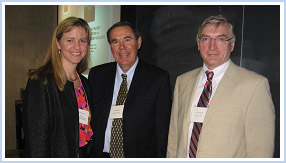

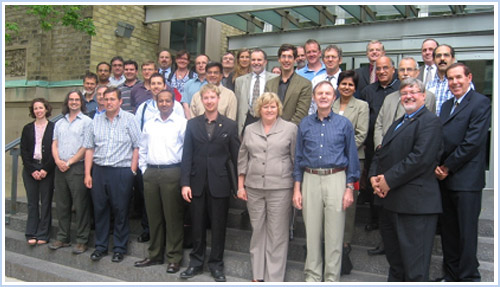
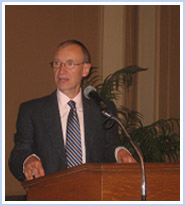
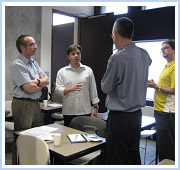 Governments and industry look to post-secondary schools to assist in making the workplace safer by integrating health and safety concepts into the curricula. A number of speakers reached out to the educators at the Institute.
Governments and industry look to post-secondary schools to assist in making the workplace safer by integrating health and safety concepts into the curricula. A number of speakers reached out to the educators at the Institute.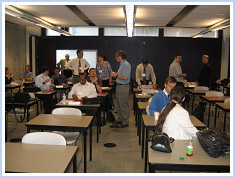 A selection of participants at this year’s Summer Institute share these thoughts:
A selection of participants at this year’s Summer Institute share these thoughts: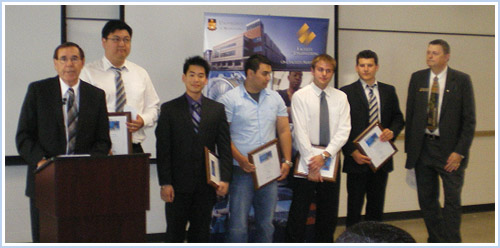
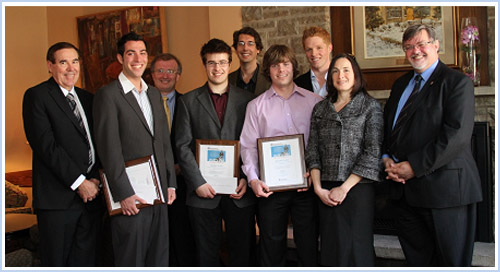
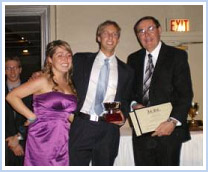
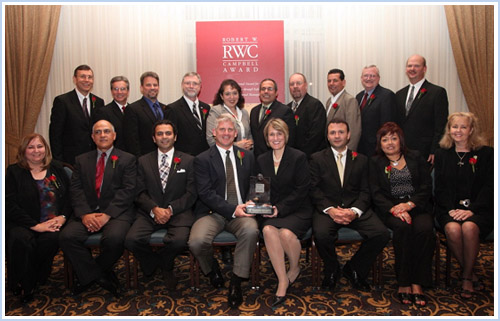
 A presentation by Graeme Norval from the University of Toronto on Minerva Canada and some leading practices for teaching occupational health and safety in engineering schools was delivered at Queen’s University during the June 2010 Canadian Engineering Education Association (CEEA) Conference. Minerva’s Vic Pakalnis and Tony Pasteris were also present to take questions from the audience. The
A presentation by Graeme Norval from the University of Toronto on Minerva Canada and some leading practices for teaching occupational health and safety in engineering schools was delivered at Queen’s University during the June 2010 Canadian Engineering Education Association (CEEA) Conference. Minerva’s Vic Pakalnis and Tony Pasteris were also present to take questions from the audience. The 